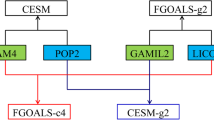Abstract
This paper examines the performance of an atmospheric general circulation model (AGCM) developed at the State Key Laboratory of Numerical Modeling for Atmospheric Sciences and Geophysical Fluid Dynamics, Institute of Atmospheric Physics (LASG/IAP). It is a spectral model truncated at R42(2.8125°long×1.66°lat) resolution and with nine vertical levels, and referred to as R42L9/LASG hereafter. It is also the new version of atmospheric component model R15L9 of the global ocean-atmosphere-land system (GOALS/LASG). A 40-year simulation in which the model is forced with the climatological monthly mean sea surface temperature is compared with the 40-year (1958–97) U.S. National Center for Environmental Prediction (NCEP) global reanalysis and the 22-year (1979–2000) Xie-Arkin monthly precipitation climatology. The mean DJF and JJA geographical distributions of precipitation, sea level pressure, 500-hPa geopotential height, 850-hPa and 200-hPa zonal wind, and other fields averaged for the last 30-year integration of the R42L9 model are analyzed. Results show that the model reproduces well the observed basic patterns, particularly precipitation over the East Asian region. Comparing the new model with R15L9/LASG, the old version with coarse resolution (nearly 7.5°long×4.5°lat), shows an obvious improvement in the simulation of regional climate, especially precipitation. The weaknesses in simulation and future improvements of the model are also discussed.
Similar content being viewed by others
References
Guo Yufu, Yu Yongqiang, and Zhang Tao, 2000: Evaluation of IAP/LASG GOALS model.IAP Global Ocean-Atmosphere-Land System Model, Zhang Xuehong et al., Eds., Science Press, Beijing, 115–137.
Hurrell, J. W., and G. G. Campbell, 1992: Monthly mean global satellite data sets available in CCM history tape format. NCAR Tech. Note NCAR/TN-371+STR, 94pp.
IPCC Third Assessment Report, 2001:Climate Change 2001, The Scientific Basis, Contribution of Working Group I to the Third Assessment Report of the Intergovernmental Panel on Climate Change (IPCC), J. T. Houghton, Y. Ding, D. J. Griggs, M. Noguer, P. J. van der Linden, X. Dai, K. Maskell, and C. A. Johnson, Eds., Cambridge University Press, 892pp.
Kalnay, E., and Coauthors, 1996: The NCEP/NCAR 40-year reanalysis project.Bull. Amer. Meteor. Soc.,77, 437–471.
Kiehl, J. T., and K. E. Trenberth, 1997: Earth’s annual global mean energy budget.Bull. Amer. Meteor. Soc. 78, 197–208.
Liang Xinze, 1986: Design of the IAP AGCM and numerical climate simulation. Ph. D. dissertation, Institute of Atmospheric Physics, Chinese Academy of Sciences, 250pp. (in Chinese)
Lin Zhaohui, Li Xu, Zhou Guangqing, Zhao Yan, and Zeng Qingcun, 1999: Extraseasonal prediction of summer rainfall anomaly over China with improved IAP PSSCA.Chinese Journal of Atmospheric Sciences,23 (4), 351–366.
Liu Hui, and Wu Guoxiong, 1997: Impacts of land surface on climate of July and onset of summer monsoon: A Study with an AGCM plus SSiB.Advances in Atmospheric Sciences,14, 289–308.
Rossow, W. B., and Y.-C. Zhang, 1995: Calculation of surface and top of atmosphere radiative fluxes from physical quantities based on ISCCP data sets. Part II: Validation and first results.J. Geophys. Res.,100, 1167–1197.
Shi, G. Y., 1981: An accurate calculation and representation of the infrared transmission function of the atmospheric constituents. Ph. D. dissertation, Tohoku University of Japan, 191pp.
Simmonds, I., 1985: Analysis of the “spinning” of a global circulation model.J. Geophys. Res.,90, 5637–5660.
Slingo, J. M., 1987: The development and verification of a cloud prediction scheme for the ECMWF model.Quart. J. Roy. Meteor. Soc.,113, 899–927.
Wang, Biao, Liu Hui, and Shi Guangyu, 2000: Radiation and cloud schemes.IAP Global Ocean-Atmosphere-Land System Model, Zhang Xuehong et al., Eds., Science Press, Beijing, 28–49.
Warren, S. G., C. J. Hahn, J. London, R. M. Chervin, and R. L. Jenne, 1988: Global distribution of total cloud cover and cloud type amounts over the ocean. NCAR Tech. Note NCAR/TN-317+STR, 107pp.
Wu Guoxiong, Liu Hui, Zhao Yucheng, and Li Weiping, 1996: A nine-layer atmospheric general circulation model and its performance.Advances in Atmospheric Sciences,13, 1–18.
Wu Guoxiong, and Coauthors, 1997: Global oceanatmosphere-land system model of LASG (GOALS/LASG) and its performance in simulation study.Quart. J. Appl. Meteorol.,8 (Supplement Issue), 15–28. (in Chinese)
Xie, P., and P. A. Arkin, 1996: Analyses of global monthly precipitation using gauge observations, satellite estimates, and numerical model predictions.J. Climate,9, 840–858.
Xue Feng, 1992: Statistical analyses of the climate simulation of the IAP FCM and the model characteristics, Ph. D. dissertation, Institute of Atmospheric Physics, Chinese Academy of Sciences, 173pp. (in Chinese)
Xue, Y., P. J. Sellers, J. J. Kinter, and J. Shukla, 1991: A simplified biosphere model for global climate studies.J. Climate,4, 345–364.
Yu Yongqiang, Zhang Xuehong, Liu Hui, and Jin Xiangze, 2000: Schemes for coupling AGCM and OGCM.IAP Global Ocean-Atmosphere-Land System Model, Zhang Xuehong et al., Eds., Science Press, Beijing, 100–114.
Yuan Chongguang, 1990: Progress in the research of shortterm climate prediction.Chinese J. Atmos. Sci.,14, 250–255. (in Chinese)
Zeng Qingcun, 1963: Characteristic parameter and dynamical equation of atmospheric motions.Acta Meteor. Sinica,33, 472–483. (in Chinese)
Zeng Qingcun, Yuan Chongguang, Zhang Xuehong, Liang Xinzhong, and Bao Ning, 1987: A global gridpoint general circulation model. Collection of papers presented at the WMO/IUGG NWP Symposium, Tokyo, 4–8 August 1986.J. Meteor. Soc. Japan, special volume, 421–430.
Zeng Qingcun, Zhang Xuehong, Liang Xinzhong, Yuan Chongguang, and S. F. Chen, 1989: Documentation of IAP Two-Level atmospheric general circulation model. DOE/ER/60314-HI, TRO44, 383pp.
Zeng Qingcun, 1990: IAP GCM and its application to the climate studies.Climate Change, Dynamics, and Modeling, The 3rd International Summer Colloquium of LASG, Zeng Qingcun et al., Eds., China Meteorological Press, Beijing, 225–256.
Zhang Xuehong, and Liang Xinzhong, 1989: Comparison and examination of the dynamic frameworks of IAP and OSU AGCM.Advances in Atmospheric Sciences,6, 265–274.
Zhang Xuehong, Bao Ning, Yu Rucong, and Wang Wanqiu, 1992: Coupling scheme experiments based on an atmospheric and oceanic GCM.Chinese J. Atmos. Sci.,16(2), 129–144.
Zhang Xuehong, Shi Guangyu, Liu Hui, and Yu Yongqiang, 2000:IAP Global Ocean-Atmosphere-Land System Model. Science Press, Beijing, 252pp.
Author information
Authors and Affiliations
Corresponding author
Rights and permissions
About this article
Cite this article
Tongwen, W., Ping, L., Zaizhi, W. et al. The performance of atmospheric component model R42L9 of GOALS/LASG. Adv. Atmos. Sci. 20, 726–742 (2003). https://doi.org/10.1007/BF02915398
Received:
Revised:
Issue Date:
DOI: https://doi.org/10.1007/BF02915398




